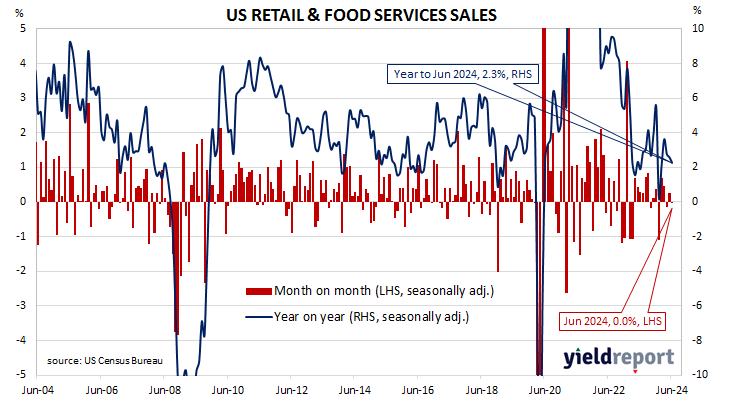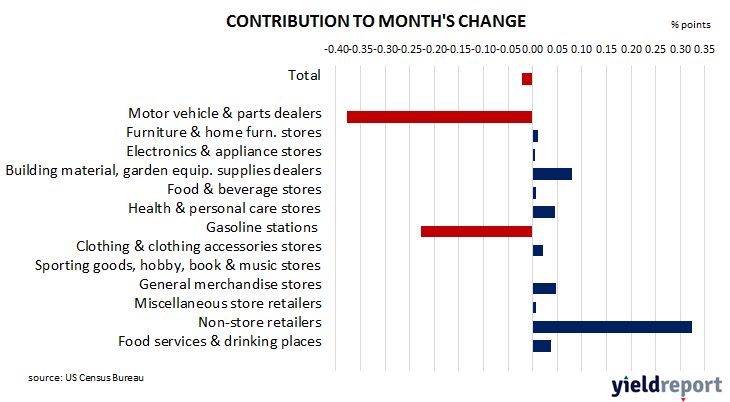Summary: US retail sales flat in June, more than expected; annual growth rate slows to 2.3%; Westpac: consumers are displaying some resilience; US Treasury yields fall; rate-cut expectations harden; ANZ: control group sales beat expectations, rises 0.9%; higher sales in ten of thirteen categories; vehicle, parts sales fall largest single influence on month’s result
US retail sales had been trending up since late 2015 but, commencing in late 2018, a series of weak or negative monthly results led to a drop-off in the annual growth rate below 2.0%. Growth rates then increased in trend terms through 2019 and into early 2020 until pandemic restrictions sent them into negative territory. A “v-shaped” recovery then took place which was followed by some short-term spikes as federal stimulus payments hit US households in 2021. However, growth rates have slowed significantly since mid-2022.
According to the latest “advance” numbers released by the US Census Bureau, total retail sales remained flat in June. The result was greater than the 0.2% decline which had been generally expected but down from May’s 0.3% rise after it was revised up from 0.1%. On an annual basis, the growth rate slowed from May’s revised rate of 2.6% to 2.3%.
“This better-than-expected report from the Commerce Department shows consumers are displaying some resilience in the US economy,” said Westpac Business Bank Chief Economist Besa Deda.
US Treasury bond yields fell by increasing amounts out along the curve on the day. By the close of business, the 2-year Treasury yield had lost 4bps to 4.42%, the 10-year yield had shed 7bps to 4.16% while the 30-year yield finished 9bps lower at 4.37%.
In terms of US Fed policy, expectations of a lower federal funds rate in the next 12 months hardened, with five 25bp cuts currently factored in. At the close of business, contracts implied the effective federal funds rate would average 5.31% in August, 2bps less than the current spot rate, 5.21% in September and 4.94% in November. June 2025 contracts implied 3.935%, 129bps less than the current rate.
“However, control group sales beat expectations, rising 0.9%,” said ANZ economist Kishti Sen. “Control group sales are important because that element is used to prepare estimates of control private consumption expenditure which is a large part of GDP. That showed resilience in consumer expenditure.”
Ten of the thirteen categories recorded higher sales over the month. However, the “Motor vehicle & parts dealers” segment provided the largest single influence on the overall result, falling by 2.0% over the month and contributing -0.38 percentage points to the total. “Non-store retailer” sales also had a large influence on the total, with a 1.9% rise for the segment and a 0.32 percentage point contribution to the total.
The non-store segment includes vending machine sales, door-to-door sales and mail-order sales but nowadays this segment has become dominated by online sales. It accounts for around 17% of all US retail sales and it is the second-largest segment after vehicles and parts.



